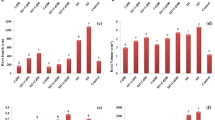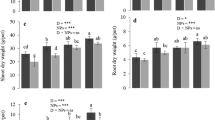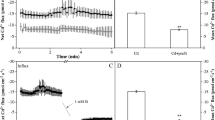Abstract
Heavy metal toxicity causes a remarkable decline in the growth and yield of numerous plant species in the agricultural system. Cadmium (Cd) among the other heavy metals is the most distinguished lethal heavy metal as its higher water solubility, relative mobility, and phytotoxicity. Silicon (Si), as a second most abundant element, has been reported to mitigate numerous abiotic stresses, comprising heavy metal stress in plants. The 2-repeated studies were conducted to disclose the protective role of silica gel derived from sodium silicate (Na2SiO3) at the rate of 1 and 3 mmol L−1 on the root morphological characters of wheat plants grown in cultured medium with three levels of Cd toxicities (0, 50, and 200 µmol L−1). The results of our studies demonstrated a remarkable alteration in morphological traits of wheat roots with both levels of Cd toxicities through incorporating an excessive amount of reactive oxygen species (ROS), by lipid peroxidation, by limitation of essential nutrient availability, and by the accumulation of the high contents of Cd in root cells. While the introduction of Si nanoparticles at the rate of 1 and 3 mmol L−1 in the cultured medium having Cd toxicities remarkably demolished Cd adversity by shifting the balance between antioxidant enzymes and oxidants of ROS. Moreover, Si significantly increased cations concentrations in root tips that compete with Cd ions for exchange sites and reduced Cd uptake and accumulation by roots. Being an effective beneficial element, Si improved root morphological characters by strengthening the antioxidative defense system and by hindering ROS in root tissues grown in a cultured medium with different toxicities of Cd.


Similar content being viewed by others
Data availability
All necessary data that supported our findings is inducted in this manuscript. Moreover, raw data related to the mass spectroscopy as well as the enzymatic study is organized in an excel sheet and will be provided on editorial request after the official acceptance of the paper.
References
Alzahrani Y, Kuşvuran A, Alharby HF, Kuşvuran S, Rady M (2018) The defensive role of silicon in wheat against stress conditions induced by drought, salinity or cadmium. J Ecotoxicol Env Saf 154:187–196
Andresen E, Küpper H (2013) Cadmium toxicity in plants. Cadmium: from toxicity to essentiality. Springer, pp 395–413
Bhat JA, Shivaraj S, Singh P, Navadagi DB, Tripathi DK, Dash PK, Solanke AU, Sonah H, Deshmukh R (2019) Role of silicon in mitigation of heavy metal stresses in crop plants. Plants 8(3):71
Birben E, Sahiner UM, Sackesen C, Erzurum S, Kalayci O (2012) Oxidative stress and antioxidant defense. World Aller Org J 5(1):9–19
Bolan NS, Duraisamy V (2003) Role of inorganic and organic soil amendments on immobilisation and phytoavailability of heavy metals: a review involving specific case studies. Aus J Soil Res 41(3):533–555
Cai K, Yu Y, Zhang M, Kim K (2019) Concentration, source, and total health risks of cadmium in multiple media in densely populated areas, China. Int J Env Res Pub Health 16(13):2269
Caverzan A, Passaia G, Rosa SB, Ribeiro CW, Lazzarotto F, Margis-Pinheiro M (2012) Plant responses to stresses: role of ascorbate peroxidase in the antioxidant protection. Gene Mol Biol 35(4):1011–1019
Chen H-Y, Yao J, Zhou Y, Chen H-L, Wang F, Gai N, Zhuang R-S, Ceccanti B, Maskow T, Zaray G (2008) Investigation of the toxic effect of cadmium on Candida humicola and Bacillus subtilis using a microcalorimetric method. J Hazard Mat 159(2–3):465–470
Chen D, Chen D, Xue R, Long J, Lin X, Lin Y, Jia L, Zeng R, Song Y (2019) Effects of boron, silicon and their interactions on cadmium accumulation and toxicity in rice plants. J Hazard Mat 367:447–455
Chérif M, Asselin A, Bélanger R (1994) Defense responses induced by soluble silicon in cucumber roots infected by Pythium spp. J Phytophathol 84(3):236–242
Choudhary A, Kumar A, Kaur N (2019) ROS and oxidative burst: roots in plant development. Plant Divers 42:33–43
Dong Q, Fang J, Huang F, Cai K (2019) Silicon amendment reduces soil Cd availability and Cd uptake of two Pennisetum species. Int J Env Res Pub Health 16(9):1624
Elliott C, Snyder GH (1991) Autoclave-induced digestion for the colorimetric determination of silicon in rice straw. J Agri Food Chem 39(6):1118–1119
Farooq MA, Ali S, Hameed A, Ishaque W, Mahmood K, Iqbal Z (2013) Alleviation of cadmium toxicity by silicon is related to elevated photosynthesis, antioxidant enzymes; suppressed cadmium uptake and oxidative stress in cotton. Ecotoxicol Env Saf 96:242–249
Fırat M, Bakırdere S, Fındıkoğlu MS, Kafa EB, Yazıcı E, Yolcu M, Büyükpınar Ç, Chormey DS, Sel S, Turak F (2017) Determination of trace amount of cadmium using dispersive liquid-liquid microextraction-slotted quartz tube-flame atomic absorption spectrometry. Spectrochim Acta Part B: At Spectrosc 129:37–41
Florijn P, Nelemans J, Van Beusichem M (1993) Evaluation of structural and physiological plant characteristics in relation to the distribution of cadmium in maize inbred lines. J Plant Soil 154(1):103–109
Frew A, Weston LA, Reynolds OL, Gurr GM (2018) The role of silicon in plant biology: a paradigm shift in research approach. Ann Bot 121(7):1265–1273
Gechev TS, Van Breusegem F, Stone JM, Denev I, Laloi C (2006) Reactive oxygen species as signals that modulate plant stress responses and programmed cell death. BioEssay 28(11):1091–1101
Han F, Shan X, Zhang S, Wen B, Owens G (2006) Enhanced cadmium accumulation in maize roots—the impact of organic acids. J Plant Soil 289(1–2):355–368
Han W, Fang J, Reich PB, Ian Woodward F, Wang Z (2011) Biogeography and variability of eleven mineral elements in plant leaves across gradients of climate, soil and plant functional type in China. J Ecol Lett 14(8):788–796
Hashemi A, Abdolzadeh A, Sadeghipour HR (2010) Beneficial effects of silicon nutrition in alleviating salinity stress in hydroponically grown canola, Brassica napus L., plants. J Soil Sci Plant Nutr 56(2):244–253
Hermans C, Verbruggen N (2005) Physiological characterization of Mg deficiency in Arabidopsis thaliana. J Env Bot 56(418):2153–2161
Hoagland DR, Arnon DI (1950) The water-culture method for growing plants without soil. Cir Calif Agr Exp St 347 (2nd edit)
Howladar SM, Al-Robai SA, Al-Zahrani FS, Howladar MM, Aldhebiani AY (2018) Silicon and its application method effects on modulation of cadmium stress responses in Triticum aestivum (L.) through improving the antioxidative defense system and polyamine gene expression. J Ecotoxicol Environ Saf 159:143–152
Huang H, Ullah F, Zhou D-X, Yi M, Zhao Y (2019a) Mechanisms of ROS regulation of plant development and stress responses. Fron Plant Sci 10
Huang L, Li WC, Tam NFY, Ye Z (2019b) Effects of root morphology and anatomy on cadmium uptake and translocation in rice (Oryza sativa L.). J Env Sci 75:296–306
Ilahi S, Wu Y, Raza MAA, Wei W, Imran M, Bayasgalankhuu L (2019) Optimization approach for improving energy efficiency and evaluation of greenhouse gas emission of wheat crop using data envelopment analysis. Sustainability 11(12):3409
Jackson AP, Alloway BJ (2017) The transfer of cadmium from agricultural soils to the human food chain. Biogeochemistry of trace metals. CRC Press, pp 121–170
Kishor K, Polavarapu B, Hima Kumari P, Sunita M, Sreenivasulu N (2015) Role of proline in cell wall synthesis and plant development and its implications in plant ontogeny. Front Plant Sci 6:544
Lian J, Zhao L, Wu J, Xiong H, Bao Y, Zeb A, Tang J, Liu W (2020) Foliar spray of TiO2 nanoparticles prevails over root application in reducing Cd accumulation and mitigating Cd-induced phytotoxicity in maize (Zea mays L). Chemosphere 239:124794
Liang Y, Nikolic M, Bélanger R, Gong H (2015) Song AJDSd. Silicon Agric 10:978–994
Liu X, Zhong L, Meng J, Wang F, Zhang J, Zhi Y, Zeng L, Tang X, Xu J (2018) A multi-medium chain modeling approach to estimate the cumulative effects of cadmium pollution on human health. J Env Pollut 239:308–317
Lu H-p, Zhuang P, Li Z-a, Tai Y-p, Zou B, Li Y-w, McBride MB (2014) Contrasting effects of silicates on cadmium uptake by three dicotyledonous crops grown in contaminated soil. J Environ Sci Pollut Res 21(16):9921–9930
Maathuis F (2009) Physiological functions of mineral macronutrients. Curr Opn Plant Biol 12(3):250–258
Malčovská SM, Dučaiová Z, Maslaňáková I, Bačkor M (2014) Effect of silicon on growth, photosynthesis, oxidative status and phenolic compounds of maize (Zea mays L) grown in cadmium excess. Water Air Soil Pollut 225(8):2056
Marschner H (2011) Marschner’s mineral nutrition of higher plants. Academic Press
Mench M, Lepp N, Bert V, Schwitzguébel J-P, Gawronski SW, Schröder P, Vangronsveld J (2010) Successes and limitations of phytotechnologies at field scale: outcomes, assessment and outlook from COST Action 859. J Soil Sed 10(6):1039–1070
Nagajyoti PC, Lee KD, Sreekanth T (2010) Heavy metals, occurrence and toxicity for plants: a review. J Environ Chem Lett 8(3):199–216
Nwugo CC, Huerta AJ (2008) Effects of silicon nutrition on cadmium uptake, growth and photosynthesis of rice plants exposed to low-level cadmium. J Plant Soil 311(1–2):73–86
Passaia G, Queval G, Bai J, Margis-Pinheiro M, Foyer CH (2014) The effects of redox controls mediated by glutathione peroxidases on root architecture in Arabidopsis thaliana. J Exp Bot 65(5):1403–1413
Rady MM, Hemida KA (2015) Modulation of cadmium toxicity and enhancing cadmium-tolerance in wheat seedlings by exogenous application of polyamines. J Ecotoxicol Environ Saf 119:178–185
Ur-Rahman S, Qi X, Zhang Z, Ashraf M, Du Z, Zhong Y, Mehmood F, Ur-Rahman S, Shehzad M (2020) the effect of silicon foliar and root application on growth, physiology, and antioxidant enzyme activity of wheat plants under cadmium toxicity. Appl Ecol Environ Res 18(2):3349–3371
Rascio N, Navari-Izzo F (2011) Heavy metal hyperaccumulating plants: how and why do they do it? And what makes them so interesting? J Plant Sci 180(2):169–181
Rasoolizadeh A, Labbé C, Sonah H, Deshmukh RK, Belzile F, Menzies JG, Bélanger RR (2018) Silicon protects soybean plants against Phytophthora sojae by interfering with effector-receptor expression. BMC Plant Biol 18(1):97
Reddy AS, Ali GS, Celesnik H, Day IS (2011) Coping with stresses: roles of calcium-and calcium/calmodulin-regulated gene expression. Plant Cell 23(6):2010–2032
Scandalios JG (2002) The rise of ROS. Tren Biochem Sci 27(9):483–486
Seregin I, Ivanov V (2001) Physiological aspects of cadmium and lead toxic effects on higher plants. Rus J Plant Physiol 48(4):523–544
Seregin I, Kozhevnikova A (2008) Roles of root and shoot tissues in transport and accumulation of cadmium, lead, nickel, and strontium. Rus J Plant Physiol 55(1):1–22
Ur Shafeeq R, Xuebin Q, Yatao X, Ahmad MI, Shehzad M, Zain M (2020) Silicon and its application methods improve physiological traits and antioxidants in Triticum aestivum (L.) under cadmium stress. J Soil Sci Plant Nutr. https://doi.org/10.1007/s42729-020-00197-y
Sharma SS, Dietz K-J (2009) The relationship between metal toxicity and cellular redox imbalance. Tren Plant Sci 14(1):43–50
Sharma P, Jha AB, Dubey RS, Pessarakli M (2012) Reactive oxygen species, oxidative damage, and antioxidative defense mechanism in plants under stressful conditions. J Bot 2012:1–12
Shi X, Zhang C, Wang H, Zhang F (2005) Effect of Si on the distribution of Cd in rice seedlings. J Plant Soil 272(1–2):53–60
Song A, Li Z, Zhang J, Xue G, Fan F, Liang Y (2009) Silicon-enhanced resistance to cadmium toxicity in Brassica chinensis L is attributed to Si-suppressed cadmium uptake and transport and Si-enhanced antioxidant defense capacity. J Hazard Mater 172(1):74–83
Song Y, Jin L, Wang X (2017) Cadmium absorption and transportation pathways in plants. Int J Phytoremed 19(2):133–141
Ur Rahman S, Xuebin Q, Zhao Z, Du Z, Imtiaz M, Mehmood F, Hongfei L, Hussain B, Ashraf MN (2021) Alleviatory effects of Silicon on the morphology, physiology, and antioxidative mechanisms of wheat (Triticum aestivum L) roots under cadmium stress in acidic nutrient solutions. Sci Rep 11(1):1–12
Ur-Rahman S, Xuebin Q, Aziz T, Zhao Z, Ashraf MN, Jiaxin C, Mehmood F (2020) Silicon attenuates acidic and alkaline stress in wheat plant by improving nutrient availability, membrane stability index and antioxidant defense system. Int J Agric Biol. https://doi.org/10.17957/IJAB/15.1472
Vatehová Z, Kollárová K, Zelko I, Richterová-Kučerová D, Bujdoš M, Lišková D (2012) Interaction of silicon and cadmium in Brassica juncea and Brassica napus. J Biol 67(3):498–504
Vázquez M, Poschenrieder C, Barceld Y (1992) Cadmium in bean roots. New Phytol 120(2):215–226
Verslues PE, Sharma S (2010) Proline metabolism and its implications for plant-environment interaction. Arabidopsis Book 8:e0140
Wael MS, Mostafa MR, Taia AAE-M, Saad MH, Magdi TAJT (2015) Alleviation of cadmium toxicity in common bean (Phaseolus vulgaris L) plants by the exogenous application of salicylic acid. J Hort Sci Biotechnol 90(1):83–91
Wang Y, Hu Y, Duan Y, Feng R, Gong H (2016) Silicon reduces long-term cadmium toxicities in potted garlic plants. Acta Physiol Planta 38(8):211
Welch RM, Shuman L (1995) Micronutrient nutrition of plants. Critic Rev Plant Sci 14(1):49–82
Wu J, Mock H-P, Giehl RF, Pitann B, Mühling KH (2019) Silicon decreases cadmium concentrations by modulating root endodermal suberin development in wheat plants. J Hazard Mat 364:581–590
Xiao R, Guo D, Ali A, Mi S, Liu T, Ren C, Li R, Zhang Z (2019) Accumulation, ecological-health risks assessment, and source apportionment of heavy metals in paddy soils: a case study in Hanzhong, Shaanxi, China. J Environ Pollut 248:349–357
Zhang Q, Yan C, Liu J, Lu H, Duan H, Du J, Wang W (2014) Silicon alleviation of cadmium toxicity in mangrove (Avicennia marina) in relation to cadmium compartmentation. J Plant Grow Regul 33(2):233–242
Zhang W, Xie Z, Wang L, Li M, Lang D, Zhang X (2017) Silicon alleviates salt and drought stress of Glycyrrhiza uralensis seedling by altering antioxidant metabolism and osmotic adjustment. J Plant Res 130(3):611–624
Zhao F, Jiang R, Dunham S, McGrath S (2006) Cadmium uptake, translocation and tolerance in the hyperaccumulator Arabidopsis halleri. J New Phytol 172(4):646–654
Zhu Y, Gong H (2014) Beneficial effects of silicon on salt and drought tolerance in plants. Agro Sust Dev 34(2):455–472
Acknowledgements
“This work is conducted by the permission of Agriculture Water and Soil Environment Field Science Research Station, China. This research work was funded by the Agricultural Science and Technology Innovation Program (Grant No. CAAS-ASTIP-FIRE-03), CAAS, and by the National Natural Science Foundation of China (Grant No. 51679241, 51709265)”(Ur-Rahman et al. 2020).
Author information
Authors and Affiliations
Corresponding authors
Ethics declarations
Conflict of interest
S. Rahman as the first author of this manuscript declares on the behalf of all remaining authors that no one has any conflict of interest.
Additional information
Communicated by S. Srivastava.
Publisher's Note
Springer Nature remains neutral with regard to jurisdictional claims in published maps and institutional affiliations.
Supplementary Information
Below is the link to the electronic supplementary material.
Rights and permissions
About this article
Cite this article
Ur Rahman, S., Xuebin, Q., Yasin, G. et al. Role of silicon on root morphological characters of wheat (Triticum aestivum L.) plants grown under Cd-contaminated nutrient solution. Acta Physiol Plant 43, 60 (2021). https://doi.org/10.1007/s11738-021-03228-y
Received:
Revised:
Accepted:
Published:
DOI: https://doi.org/10.1007/s11738-021-03228-y




